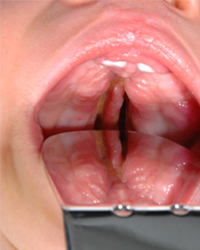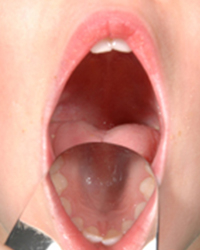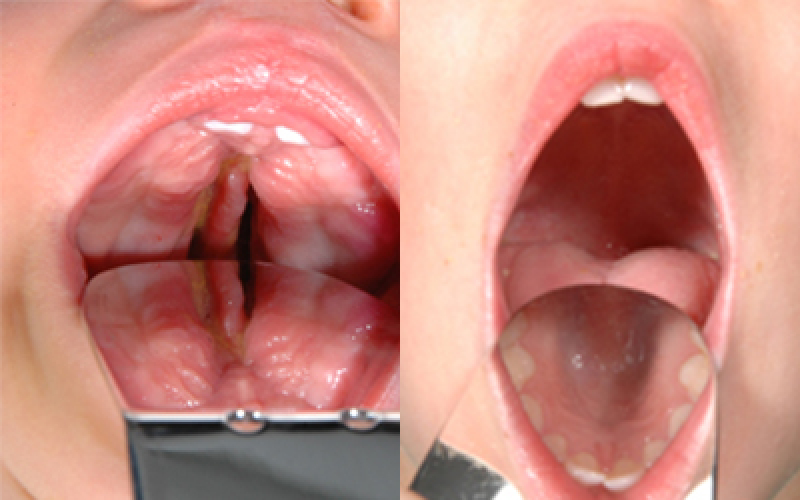Clef Lip / Palate Surgery in Dallas, TX
Parents of children born with a cleft lip/palate have lots of concerns, all of which can be addressed by the caring and compassionate physicians of the International Craniofacial Institute in Dallas, Texas.
Oro-facial clefts are generally visible, but some characteristics (such as poorly positioned middle-ear components) may only be determined with the help of x-rays, tests, etc. During a newborn’s exam, we’ll gently and thoroughly investigate these structures, including the soft palate at the back of the mouth and the underlying submucous membrane in the bony palate. A doctor from The International Craniofacial Institute will evaluate and diagnose the extent and complexity of the physical anomalies, create a treatment plan, and provide practical infant care instruction to you, as well as supportive information to help you help them, as we take them through the various repair stages in childhood, adolescence, and the teen years.
This section includes information on the following:
- Nutrition and Nurture
- Feeding Devices and Details
- Positioning, Patience, and Points of Concern
- Acceptance and Adjustments
- Sound Strategies – Communication Is Critical
- Treatment – Professional Team and Proper Timing
Nutrition and Nurture
One of a newborn’s most urgent desires is to be fed, not only with the proper quality and quantity of milk but also with love and care. Although a mother’s most pressing concern may be related to feeding her child according to a planned/preferred method, the cleft condition demands reconsideration of these plans in light of new priorities. Your immediate goal will be to provide adequate nutrition, as well as nurture. The practical limitations of a cleft will require that you do what best meets these demands, even if it differs from what you’ve envisioned. For example, although breast milk optimizes growth and development, your baby’s suckling strength and endurance may not adequately stimulate let-down, preventing him or her from receiving the necessary amount of breast milk for such growth. For this reason, we ask parents to consider methods such as bottle or cup feeding. Importantly, this doesn’t preclude providing breast milk. A mechanical breast pump may enable you to obtain enough of your own milk for use in a bottle or a cup.
Feeding Devices and Details
Whether you choose formula or breast milk for your baby, we can direct you to a number of specialized bottles and devices for simplified, safe feeding. The best choice for your child will depend on his or her mouth and palate size/shape, as well as his or her feeding “pace.” Bottles with large cross-cut openings allow the infant to use chewing and suckling motions to obtain milk at the rate and amount they desire.
We recommend the following products, among other choices. Mead Johnson’s Cleft Palate Nurser provides a long, soft, cross-cut nipple, as well as a squeezable bottle for parent-directed flow control. Another option, the Ross Cleft Palate Nurser, has an adjustable nipple length to enable rate control while requiring minimal sucking strength. If taking in too much air is a concern, the SpecialNeeds Feeder (formerly known as the Haberman Feeder) allows the parent to squeeze out excess air prior to feeding while also accommodating three flow rates. Further, some nipples are designed with attached wings to help close the cleft and prevent nasal uptake or leakage. If neither a specialized bottle nor a cup provides your baby with enough nutrition, we’ll teach you to use the Breck Feeder (a syringe with a feeding tube extension).
Positioning, Patience, and Points of Concern
Your baby will take in milk most easily and safely when you cradle him or her in a semi-sitting position, body upright and head tilted slightly back. This posture enables swallowing without milk entering the nose. Yet even with proper positioning, babies with clefts are prone to taking in extra air during feeding, so you’ll want to burp them gently but frequently.
If your baby takes in milk very quickly, the milk may strike the back of the throat and trigger the choking reflex. Simply adjust the flow rate to stop this problem. To determine the optimum nipple opening size, try tipping the full bottle upside down. If the nipple opening leaks milk, the hole/cut is too large and may allow milk to flow too quickly into your baby’s mouth. The flow rate will be about right when the full, upside-down bottle doesn’t drip.
On the other hand, a cleft may cause your baby to take in milk very slowly, requiring patience and planning so he or she obtains enough nutrition. If your child drinks too slowly, he or she may tire before taking in the right amount of milk. For this reason, we ask you to monitor your baby’s weight gain carefully: his or her weight should double by the age of two and a half to three months of age. We also ask you to watch for common dehydration or malnutrition signs, such as too few wet diapers, constant fatigue, or lethargy. If necessary, we’ll work with you to master the most effective techniques for supplementation. We encourage you to contact us immediately with any concerns or questions about your baby’s physical condition, weight, or demeanor. Our goal, like yours, is a healthy child. We often monitor high-risk babies with weekly weight check/feeding support visits to our offices.
Acceptance and Adjustments
At first, these differences in feeding may feel strange, or even wrong, compared to what you’d planned. However, your concerns will naturally shift from, not being able to feed your baby as you’d envisioned, to focusing on a solution and adjusting to the situation. Soon, you’ll master the skills needed to provide the very best nurture and nutrition for your baby. Your calm resolve and loving physical affection will provide stability and assurance for your child. Instinctively, he or she will recognize that you are meeting emotional as well as physical needs. This, in turn, allows the child to accept and adapt to the feeding method you select. Try to relax and enjoy the bonding. Hold and cuddle your baby while feeding, patiently allow plenty of time for milk intake, and speak gently to him or her both during meals and throughout your daily activities.
As you and your child adjust to these feeding challenges, you’ll be rewarded with increases in his or her size, strength, and endurance – all are essential for surgery preparation. Your child’s body will store reserves vital to withstanding anesthesia and post-operative healing. Further, as the baby’s mouth and palate grow, it will be easier for the surgeon to perform the meticulous oral work required. Back to top.
Sound Strategies – Communication Is Critical
Because a cleft lip and/or palate can affect your baby’s pre-speech sound development, our team’s speech therapist carries out an early examination, evaluation, and teaching plan. Even prior to palatal surgery, your child can learn to focus and create various sounds. In fact, it’s important to encourage your baby’s language experimentation, as natural curiosity prompts them to develop speech. Eventually, several months down the road, palatal surgery will give your child a more normal oral space in which to begin forming correct speech.
Further, we need to assess and monitor your child’s hearing, as speech and hearing abilities are intertwined. Due to the cleft, it’s common for the middle and/or inner ear to develop at an improper angle, making complete drainage difficult. Over time, this can cause chronic ear infections, requiring surgical insertion of tubes to enable efficient drainage instead of allowing fluid build-up, pressure, pain, and complications. Back to top.
Treatment – Professional Team and Proper Timing
Fortunately, cleft lip/palate conditions are surgically repairable. Our team will evaluate your child and plan a treatment to create excellent function, form, and appearance of the entire oral-facial area. Because the cleft can cause anomalies and dysfunction in other components of the baby’s mouth, jaws, and ears, our plan includes several kinds of repair, specialists for each area, and a time frame to fit the child’s natural developmental windows – without disrupting or altering the natural growth patterns.
Children with clefts typically require both surgical and orthodontic intervention, since the cleft area affects the shape of the dental arch, how the teeth come in, and how the child’s bite lines up. A child’s constant growth also means that the oral-facial structures go through ongoing change and maturation even while we plan and implement corrections. To successfully and permanently control the eventual look and function of the mouth, we time each procedure to align with the child’s natural facial and dental development stages – thus, the child grows with the treatment.
Specifically, we design your child’s treatment plan to coordinate with predictable stages of maturity during which we can most effectively intervene. After our team completes a thorough diagnostic exam of your child’s condition, we’ll explain how these stages apply to your child’s particular case. We’ll also provide an ongoing analysis of your child’s progress throughout each stage, making adjustments based on your child’s response to treatment. Your careful involvement, supportive attitude, and patience will go a long way toward the success of our work. In fact, your commitment is essential to our ability to obtain the best possible function and appearance for your child.
Why Choose International Craniofacial Institute?
Since its founding by Dr. Kenneth Salyer in 1971, the International Craniofacial Institute has gained worldwide recognition as being one of the most advanced facilities in the treatment of craniofacial disorders. The complexity of the field means we understand our patients have an array of dental, medical, psychosocial, and surgical needs. To address these issues, our team consists of many dedicated professionals who represent more than 15 disciplines of specialty. Our physicians have successfully treated more than 17,000 patients from more than 30 different countries. We additionally train surgeons from many world locations in the advanced techniques required for craniofacial diagnosis, surgical correction, and repair.
If you have a child or another family member who is suffering from a genetic syndrome or has a cleft lip, cleft palate, or craniofacial complication, the staff at the International Craniofacial Institute can help. Contact us today to talk with the doctors and staff about your options and how we can help.


